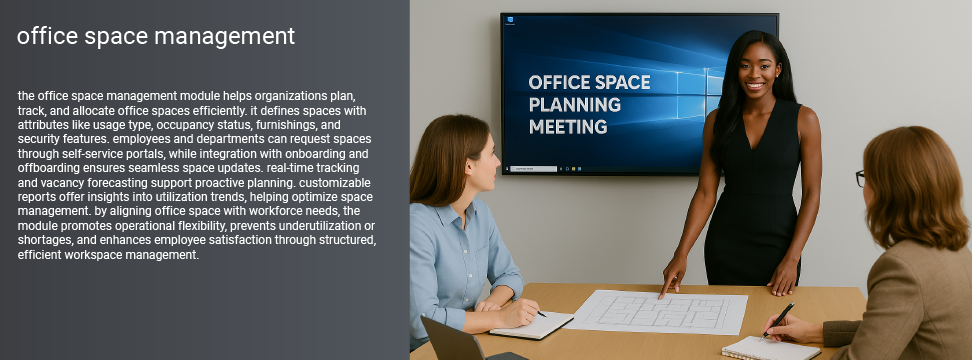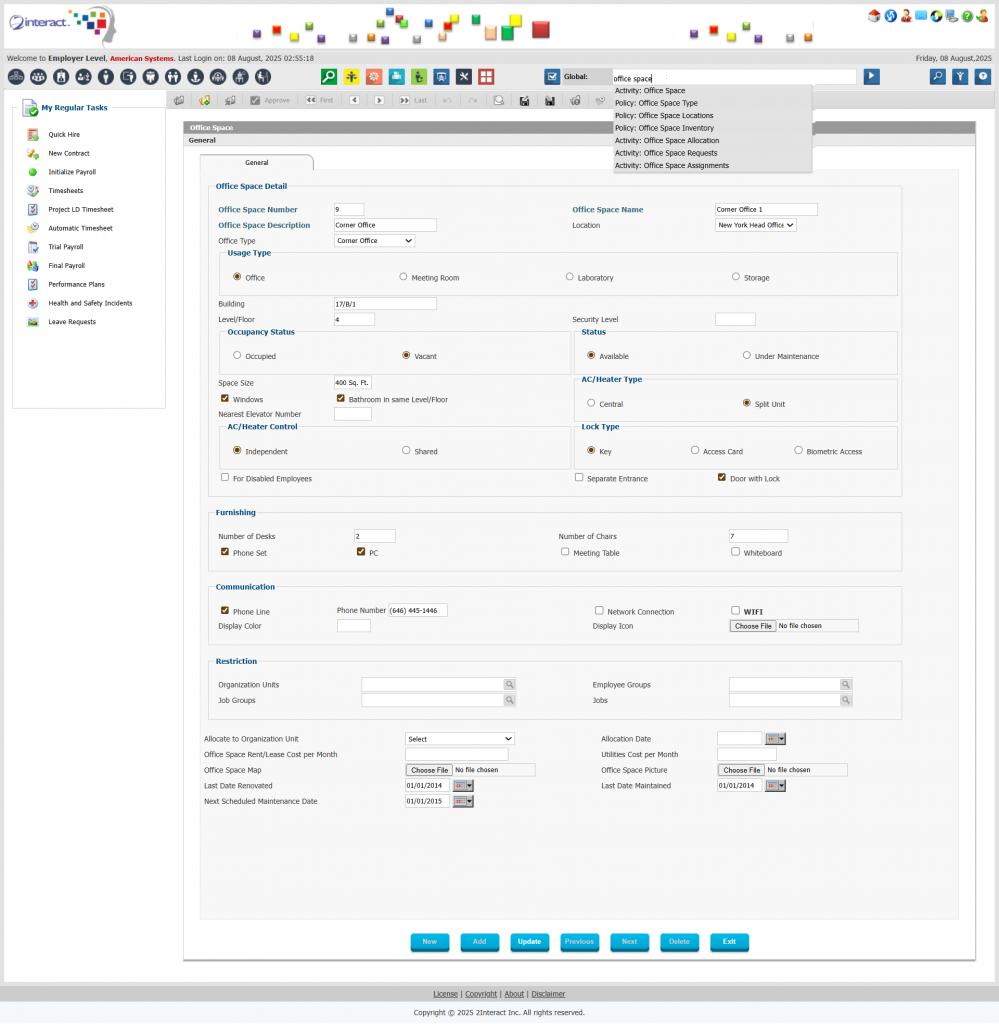Interact HRMS Office Space Management Module Overview
Figure 1: Office Space Inventory Definition
The Interact HRMS Office Space Management module offers organizations an efficient solution for planning, tracking, and managing office spaces to align with manpower and recruitment needs. This module allows HR and facilities teams to effectively utilize office spaces, ensuring that there is neither underutilization nor a shortage of workspace. With tools for tracking office space usage, managing occupancy, and handling employee and departmental space requests, the Office Space Management module helps organizations optimize their physical workspace and supports strategic workforce planning.
Office space management is essential for organizations aiming to balance employee needs with available resources. By defining office spaces in detail and integrating the module with onboarding and offboarding processes, companies can manage workspace allocation efficiently and maintain flexibility as staffing levels change. Additionally, the module’s self-service functionality empowers employees and departments to request office space as needed, making it easy to respond to evolving workforce requirements.
Comprehensive Office Space Definition and Inventory Management
The Office Space Management module allows organizations to define and categorize every type of office space within their facilities. Each office space can be customized with specific attributes that provide a complete description of its features, making it easier for HR and facilities teams to manage allocation and usage. The module supports defining office spaces by:
- Usage Type: Categories such as office, meeting room, laboratory, or storage space, allowing organizations to allocate spaces based on specific functional needs.
- Occupancy Status: Whether the space is currently occupied or vacant, providing a real-time view of availability.
- Space Size: The size of each office space, which helps in determining the suitability of a space for specific departments or teams.
- Windows: Whether the space includes windows, as this may be a preference for certain employees or teams.
- Nearest Elevator Number: Indicates proximity to the nearest elevator, offering a convenience factor for employees with mobility needs.
- AC/Heater Control: Whether the space has independent or shared climate control, allowing HR to meet individual comfort requirements.
- Furnishing Details: Information on furnishings, such as the number of desks, chairs, phones, PCs, meeting tables, and whiteboards, so employees know what resources are available in each space.
- Lock Type: Security details, including access control options such as key, access card, or biometric access.
This comprehensive inventory management system enables organizations to maintain a structured and detailed database of office spaces. By defining office spaces with these attributes, companies can ensure that employees are assigned to spaces that meet their needs and preferences, while also promoting efficient use of available facilities.
Optimized Office Space Planning for Efficient Utilization
The Office Space Management module is designed to help organizations optimize the use of their available office space, preventing both underutilization and overcrowding. By aligning office space planning with manpower and recruitment forecasts, HR teams can ensure that workspace is ready for new hires and that existing employees have access to appropriate spaces. This proactive approach to office space planning supports strategic workforce management, ensuring that facilities evolve in step with organizational growth.
The module also provides an overview of current and projected space usage, helping organizations identify upcoming vacancies and opportunities for reallocation. For instance, if a space is expected to become vacant soon due to employee departures or team restructuring, the module allows HR to plan its reassignment in advance, avoiding gaps in occupancy. By continuously tracking space usage and future vacancies, the module ensures that office space is utilized efficiently, supporting productivity and employee satisfaction.
Self-Service Capabilities for Space Requests
The Office Space Management module includes self-service capabilities that allow both employees and departments to request office spaces. Through the self-service portal, employees can view available spaces and submit requests based on their preferences or functional requirements. Departments can also use self-service to request office spaces for their teams, making it easy to coordinate space allocations in line with departmental needs.
These self-service options reduce administrative workload for HR and facilities teams by allowing employees to manage their workspace needs independently. When a request is submitted, HR can review and approve it based on available resources and organizational priorities. This streamlined process helps ensure that office space is allocated efficiently and fairly, promoting convenience for employees and enhancing operational efficiency.
Integrated with Onboarding and Offboarding Processes
The Office Space Management module is fully integrated with the Onboarding and Offboarding modules within Interact HRMS, ensuring that office space assignments are seamlessly updated throughout the employee lifecycle. During onboarding, HR teams can assign office spaces to new employees, making sure that they have a designated workspace from their first day. This integration simplifies the onboarding process, providing new hires with a welcoming and organized environment.
Similarly, during the offboarding process, the module ensures that office spaces assigned to departing employees are released and made available for reassignment. This feature supports efficient space turnover, allowing organizations to manage workspace availability proactively as staffing changes occur. By linking office space management with onboarding and offboarding, the module helps organizations maintain optimal space utilization and reduces the time required to assign spaces to new employees.
Real-Time Occupancy Tracking and Vacancy Forecasting
The module provides real-time tracking of office space occupancy, allowing organizations to monitor which spaces are currently in use and which are vacant. This real-time visibility helps HR and facilities teams make informed decisions about space allocation and quickly identify available spaces for immediate use. Additionally, the module supports vacancy forecasting, enabling organizations to anticipate future availability based on known departures or team restructuring.
With this tracking and forecasting capability, organizations can plan ahead to ensure that there is always adequate workspace for incoming employees. For example, if a department is planning to expand, HR can use vacancy forecasts to identify suitable office spaces that will become available within the desired timeframe. This proactive approach to office space management helps organizations avoid sudden space shortages and ensures a smooth transition for employees.
Grouping and Reporting on Office Space Inventory
The Office Space Management module enables users to group and report on office space inventory, providing valuable insights into space usage patterns and availability. Office spaces can be grouped by attributes such as usage type, occupancy status, or location, allowing organizations to view and analyze their space distribution. This grouping functionality makes it easy for HR and facilities teams to assess how office space is allocated across the organization and identify opportunities for optimization.
The module’s reporting capabilities offer a comprehensive overview of office space usage, helping organizations make data-driven decisions about space planning and allocation. For example, HR can generate reports on occupied versus vacant spaces, upcoming vacancies, and departmental space assignments. These insights allow organizations to manage office space strategically, ensuring that resources are allocated to support both employee needs and operational goals.
Detailed Office Space Attributes for Enhanced Allocation
The module allows organizations to define office spaces with a variety of attributes, helping ensure that employees are assigned to spaces that meet their specific requirements. Key attributes include:
- Usage Type: Defines the purpose of each space, such as offices, meeting rooms, or storage, allowing organizations to allocate spaces based on functional requirements.
- Occupancy Status: Tracks whether a space is occupied or vacant, providing real-time visibility into space availability.
- Space Size: Ensures that the size of the space aligns with its intended use, whether it’s for an individual office, shared workspace, or conference room.
- Windows and Lighting: Indicates the presence of windows, helping employees choose spaces that match their preferences.
- Furnishing Details: Specifies the number of desks, chairs, and other furnishings, allowing employees to know what resources are available in each space.
- Lock Type: Provides information on security access, including key, access card, or biometric options, to meet various security requirements.
These attributes help organizations make informed decisions about space allocation, ensuring that each space is used effectively and meets the specific needs of employees.
Customizable Reports and Analytics for Office Space Utilization
The Office Space Management module provides a variety of customizable reports and analytics that offer insights into office space usage, occupancy rates, and future availability. These reports allow HR and facilities teams to track space utilization trends, monitor upcoming vacancies, and assess space requirements for future staffing plans. By generating regular reports, organizations can identify areas for improvement in space allocation and make data-driven decisions to optimize office space.
For example, a company may generate a report to analyze underutilized spaces, helping them identify areas that could be repurposed for new teams or shared workspaces. These insights support more efficient use of facilities and ensure that office space aligns with organizational growth and employee needs.
Summary: Interact HRMS Office Space Management
The Interact HRMS Office Space Management module provides a structured solution for planning, tracking, and managing office spaces. Key benefits include:
- Comprehensive Office Space Definition: Define office spaces with detailed attributes, including usage type, occupancy status, and furnishing.
- Optimized Office Space Planning: Align office space allocation with manpower and recruitment plans to avoid underutilization or overcrowding.
- Self-Service for Space Requests: Enable employees and departments to request office space through a user-friendly self-service portal.
- Integration with Onboarding and Offboarding: Ensure seamless space assignments for new hires and quick turnover for departing employees.
- Real-Time Occupancy Tracking and Vacancy Forecasting: Monitor space availability in real-time and anticipate future vacancies.
- Grouping and Reporting on Inventory: Group and analyze office spaces based on various attributes for informed decision-making.
- Detailed Office Space Attributes: Define spaces with attributes like furnishing, security access, and climate control to meet specific employee needs.
- Customizable Reports and Analytics: Access insights into office space utilization to support data-driven space management.
By combining these features, the Office Space Management module enables organizations to allocate workspace efficiently, promote optimal utilization, and support employee satisfaction through well-managed office facilities. This structured approach to space management helps organizations adapt to changing workforce needs while maintaining operational flexibility and efficiency.


